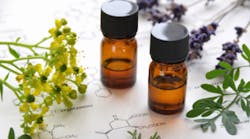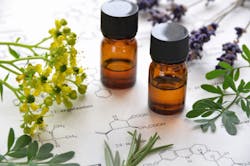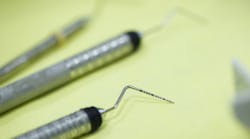Essential oils: The multiple role of the oils in dental treatment
By Jamie Collins, RDH, CDA
The popularity of essential oils has blossomed throughout recent years, and its use in dentistry is no exception. This form of holistic medicine has been around since the ancient ages and becoming more popular as Americans are looking for holistic healing versus the chemical alternatives. Essential oils are used for a variety of ailments and prevention, and are believed to aid the mind, body, and spirit.
To produce the essential oils, one of two processes are used—either extraction or distillation—and it depends on the source it is derived from. All essential oils are derived from a plant source—whether it be from the leaf, root, bark, flower, or fruit. The art of processing pure essential oils often requires many, many pounds of the plant source to obtain a very small amount of the essential oil. In turn, the pure therapeutic grade oils produced are often costly. Most pure essential oils are so potent they must be diluted for safe use.
With nearly 3,000 known essential oils, there are endless possibilities to choose from, each with a list of potential benefits. The use of coconut oil is the most common oil used in the United States, which is thought to diminish oral bacteria and draw toxins from the body while providing an antioxidant effect. In addition, sesame and sunflower oils may also be used in the practice of oil pulling.
Oil pulling
The ancient practice of Ayurdevic medicine that evolved 3,000 to 5,000 years ago believed that oil-pulling was the body’s way of healing, and it has been used in the world’s cultures for centuries. The general recommendation is to rinse with the oil 10 to 20 minutes and expectorate, the oil binds to the bacteria and draws the toxins from the body. I have read studies that have stated the oral efficacy of oil pulling is comparable to chlorhexidine rinse in reducing gingivitis and bleeding.
Studies also show that coconut oil, which is not an essential oil (but is used to dilute essential oils), has a comparable effect on reducing the S. Mutans bacterial count with no adverse effect on health, and can be used as a preventative therapy at home in conjunction with professional and recommended homecare treatments.(1)
For patients interested in the homeopathic and therapeutic use of oil-pulling, I personally cannot find a contraindication for it. The use is considered safe, and, unlike chlorhexidine, it is non-staining. The downside of oil pulling it is a time commitment, and it can be difficult to rinse for 10 to 20 minutes for many people, not to mention it is hard to rinse for a prolonged period of time.
Aromatherapy
Essential oils may also be used as aromatherapy through the use of diffusers. They not only provide a pleasant smell but can help the memory, mood, and hormones. Some offices will have a diffuser in the practice, but they should keep in mind that any product in the office must also have a material safety data sheet (MSDS) accompany it.
Lavender oil, or a mixture containing lavender, provides a soothing anti-anxiety aromatherapy choice and has been suggested for reducing the pain of the injection upon needle insertion.
Lavender is a favorite additive to Epsom salts for relaxation and stress relief. As we all know after years in dentistry, the back and shoulders may ache at the end of the day. I personally find Epsom salt infused with lavender in the bath will often relax a sore back or hip.
Many will use roller applicators to apply essential oils topically to the skin for everything from stress relief, migraines, and allergy relief, among others. They are often in a suspension that is easily absorbed and quickly circulated throughout the body to stimulate and boost the immune system.
For beginners, many products on the market are already prepared for use, where others offer the ability to mix on your own. Finally, essential oils may be ingested by placing the oil under the tongue for absorption, adding it to foods, or taking in a capsule form. However, prior to ingesting any oil be sure it is safe for consumption.
Antibiotic properties
With antibiotic-resistant bacteria becoming more common, it is increasingly more important to find an alternative or additive products. Essential oils, unlike antibiotics, do not appear to have resistant properties or loose efficacy over time. The antibacterial, antifungal, antioxidant, and anti-inflammatory properties of various essential oils for oral and overall health are intriguing to me as well as many others.
While many of the traditional methods to treat infections and disease are necessary, prevention and maintenance is imperative to a long healthy life. With the ability to use natural ingredients to prevent and treat ailments and reduce the dependence on medications it may provide life long relief for many.
Peppermint, clove, and cinnamon oil
When clinicians think about essential oils, many of us first think of toothpaste and mouthwash. With so many to choose from it can be overwhelming to patients. The most common ingredient found in over-the-counter dental products is peppermint, which is in most mouthwashes and toothpastes.
Peppermint is one of the most widely used essential oils in oral care products, widely due to the antibacterial, antifungal, and biofilm-inhibiting properties. Peppermint oil has the ability to inhibit biofilm formation in the oral cavity in addition to providing a therapeutic benefit treating periodontitis, gingivitis, and halitosis.(2).
In addition to peppermint oil, clove oil is also widely used in dentistry. The proven properties of antifungal, antioxidant, and antibacterial properties make it a commonly added ingredient in eugenol-based dental products. If you have ever had dry socket paste in the office, you will recognize the strong smell of clove oil. Clove oil has been proven to have a strong inhibitory effect on Staphylococcus, which is often antibiotic resistant.
Cinnamon oil has also been shown to have properties related to inhibit the growth of Gram-positive and Gram-negative bacterial and fungi. An interesting effect of cinnamon essential oil when administered orally on animals is the anti-melanoma effect it may possess. This may be related to the antioxidant and free radical scavenging effects of cinnamon.
The benefits of cinnamon oil extend beyond the oral cavity to the whole body and endocrine system. It indicates to have an anti-mutagenic effect that can protect against spontaneous mutation in human cells. Cinnamon is often recommended to diabetics and insulin-resistant individuals to improve insulin sensitivity, thus often helping with glucose control. It can also improve the systolic blood pressure, and body fat percentage. Whether it is taking a cinnamon supplement, application in the oil-form, or sprinkling a little cinnamon on your morning latte, it may help improve insulin productivity. Cinnamon oil can be effectively used for candidiasis, which diabetics are more prone to with a suppressed immune system.
Additionally, lemon oil has been shown to inhibit some strains of Candida and can be effective for denture wearers.
Melaleuca
Melaleuca, also known as tea tree oil, has been proven to have many uses, ranging from cleaning the house to wound application. It also shows great promise in the oral cavity. The use of Melaleuca has been suggested to provide therapeutic properties for periodontal disease, apthous ulcers, caries prevention, and toothaches. It has been shown to inhibit the bacterial colonization and dental biofilm through many studies.
The ability of tea tree oil to have an anti-cariogenic effect makes it a good essential oil choice that is added to a variety of products. I personally have used a variety of products containing Melaleuca for shampoo, house cleaning products, and as an additive to oral care products. Melaleuca oil is one of my personal favorites for many different uses, including as an antiseptic.
Oral care delivery
With so many choice and options, it is often hard to find what the best option of essential oils, as well as the best method of delivery. No two patients are the same; therefore, the same method does not work for all. In my opinion, one of the best options of oral delivery methods is through a Waterpik Water Flosser or oral irrigator. Waterpik has models that are designed with the ability to withstand use of additives to the water without damaging the unit or tubing.
Many patients will often ask me about an additive, whether it is adding their favorite mouthwash or essential oil. I have encouraged patients to add their choice of essential oil or mouthwash to the water, if they choose to. For many years, I have recommended the use of a Waterpik device to all patients with periodontal disease and implants. It provides the ability to irrigate and will clean where floss cannot reach, especially at the base of pockets. In practice, I have seen great improvement in many of these patients with use of a Waterpik device. Adding either a rinse or essential oil allows the antibacterial and antimicrobial benefits to be multiplied.
Oral Essentials makes a line of rinses and pastes that are derived from a group of natural ingredients such as Dead Sea salt, mint, clove, aloe, and xylitol among others. This can be a good alternative for those who are looking for a holistic method of treatment without any of the chemical additives. There are many homeopathic products that are available online and in stores. Take the time to research the ingredients to ensure they contain good quality essential oils and ingredients.
While a quality essential oil or combination of oils can be expensive, it is an investment in your systemic and oral health. The benefits of a natural and homeopathic treatment and prevention plan can reduce the need for antibiotic and other medication therapies, encouraging a happy and healthy body, mind and spirit.
Jamie Collins, RDH, CDA, resides in Idaho with her husband, Cory, and their four children. She currently works as a full-time hygienist as well as an educator at the College of Western Idaho. In addition, she acts as a content expert and contributor in multiple upcoming textbooks. She can be contacted at [email protected].
References
1. https://www.ncbi.nlm.nih.gov/pubmed/15367192
2. https://www.ncbi.nlm.nih.gov/pmc/articles/PMC4606594/



